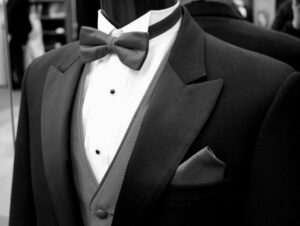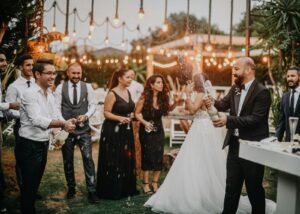Deciding when to wear a tuxedo can often feel like navigating a sartorial minefield. Traditionally reserved for the most formal of occasions, the tuxedo embodies sophistication and class. But with evolving fashion norms, it’s essential to know the traditional and modern rules of this elegant attire.
I’ve often found that wearing a tuxedo is about striking the perfect balance between the event’s formality and personal style. While it’s clear that tuxedos are a staple for evening events like galas and operas, understanding the nuances of daytime and less formal gatherings can be tricky. Let’s dive into when and where a tuxedo is the ideal choice, ensuring you always make a sharp, appropriate appearance.
Understanding Tuxedo Etiquette
Navigating tuxedo etiquette is essential for maintaining sartorial excellence at formal events. This guide covers the basic principles and timing considerations to ensure you’re impeccably dressed for every occasion.
The Basics of Black Tie
The term “black tie” refers to the formal dress code that typically requires a tuxedo. A classic black tie event attire ensemble includes a tuxedo jacket, often with satin lapels, matching trousers with a satin stripe, a crisp white dress shirt, and a black bow tie. Accessories should complement the ensemble without overpowering it, including items like cufflinks with French cuffs and a cummerbund or a low-profile vest. Shoes are traditionally black patent leather, polished to perfection.
The general rule for black tie attire is precision and simplicity, ensuring each element displays clean lines and proper fit. It’s the go-to choice for major formal events such as galas, opera nights, and elaborate receptions.
Time of Day Considerations
Black tie events are overwhelmingly evening affairs. Etiquette experts consistently advise wearing tuxedos only after 6 PM to respect the day’s formality progression. Morning and afternoon events typically call for less formal attire, such as dark suits or even semi-formal dress if specified by the host.
For those questioning tuxedo vs suit, remember that a tuxedo is ideal for black-tie evening events, while suits are more versatile for daytime or business attire. This distinction helps maintain the tuxedo’s role as a symbol of elegance and celebration.
Occasions for Wearing a Tuxedo
Determining the right moment to wear a tuxedo is essential for matching the required dress code of various gatherings and celebrating the elegance of traditional formal attire. Here, I’ll break down the appropriate instances to choose a tuxedo over other forms of dress.
Formal Events and Gatherings
Formal events, often categorized as ‘black tie,’ unequivocally call for a tuxedo. At these gatherings, the classic black tie ensemble—consisting of a tuxedo jacket, matching trousers, a crisp white dress shirt, and a black bow tie—is not just tradition but a formal dress code requirement. High-profile galas, awards ceremonies, and some charity balls fall under this category where the elegance of a tuxedo complements the gravity and formality of the occasion. It’s important to check if the event specifies ‘black tie optional,‘ which permits a dark suit as an alternative, though a tuxedo remains the go-to choice for the ultimate formal style.
Weddings and Celebrations
Weddings are a prime arena for dressing to impress, and there’s no better way to do so than in a tuxedo, especially if the invitation calls for black tie attire. For evening weddings, a tuxedo is a splendid choice that aligns with the romantic and celebratory nature of the event. Look for cues in the wedding invitation: an elaborate reception typically suggests more formal attire, which makes donning a tuxedo appropriate. Moreover, playing a significant role in the wedding, such as being part of the groom’s party or a best man, often necessitates wearing a tuxedo as a mark of honor and respect for the event.
Performing Arts and Culture
Attending high-culture events such as operas, ballets, or significant theatrical performances often warrants more formal attire. Here, a tuxedo fits perfectly. These occasions are not only about the performances but also about embracing the tradition and experiencing the societal aspect of the arts.
For premieres or opening nights, wearing a tuxedo respects the creators’ work and the formality of the event. If the event specifies a strict formal dress code guidelines, adhering to black-tie standards ensures you meet the expectations of the evening.
By understanding and adhering to these guidelines, I ensure that my choice to wear a tuxedo is both appropriate and appreciated, enhancing my experience and aligning with the expected social etiquettes of these grand occasions.
How to Wear a Tuxedo Properly
Mastering tuxedo attire requires a keen eye for detail and an understanding of formal dress code standards. Let’s explore the pivotal elements of styling a tuxedo properly, ensuring you portray elegance and sophistication at any formal event.
Choosing the Right Jacket
The focal point of all tuxedos, the jacket, demands careful selection. A classic black tuxedo jacket with satin lapels epitomizes formal style, making it a go-to choice for black tie events. However, variations like the shawl collar or a double-breasted suit offer a distinctive look that can elevate your appearance. Jacket lapels generally come in two styles: peaked and shawl. Peaked lapels, being the more traditional pick, are recommended for their timeless appeal and formal congruity. If you prefer a less conventional yet still formal style, consider a jacket with a shawl collar. Additionally, avoid jackets with belt loops or any embellishment that might undermine the formal integrity of the outfit.
The fit of your jacket plays a critical role in your overall appearance. It must hug your shoulders perfectly without any slack at the back. The sleeves should end just above the wrist, allowing about half an inch of your shirt cuff to show, a nod to classic black tie etiquette.
Selecting Accessories: From Bow Ties to Shoes
Choosing the right accessories is crucial for completing your tuxedo ensemble. A black bow tie, preferably in silk, is non-negotiable for traditional black tie attire. If you’re attending a more modern or less stringent black tie affair, a necktie in a conservative pattern might be acceptable. Yet, for the most formal occasions, stick to a classic black bow tie.
When it comes to shirts, select a crisp white tuxedo shirt with French cuffs. These cuffs permit the addition of cufflinks, a subtle detail that enhances the sophisticated nature of your attire. Make sure the shirt is well-pressed and pristine, matching the formal tone of the event.
For footwear, black patent leather shoes are the standard. They should be clean and polished, with a preference for laced styles over loafers to maintain the formal aesthetic. As for socks, always choose long black silk ones that rise up the calf. This ensures that no skin is visible when you sit down—a commonly accepted practice to uphold the formal appearance integral to black tie occasions.
In short, wearing a tuxedo is not just about selecting a jacket and trousers; it’s about paying attention to each component and accessory to ensure your look is coherent and appropriate for the significance of the event.
- The fashionable dinner jacket is made of high-quality durable light weight fabric, giving you unique texture and comfortable wearing experience, finished by excellent stitching.
- The single-breasted blazer is feature with regular fit, shawl collar, one button closure, one front pocket,two side flap pockets and two inside pockets, allover classy paisley embroidered pattern makes it a head turner.
- Can partner the prom suit jacket with a plain front, pleated or bib front formal shirt, a bow tie, tuxedo trousers and a pair of leather shoes for a sharp look to become a hit among the crowded.
- The floral suit blazer will give you style and pizzazz in occasions like 80's prom, banquet, dinner, weddings, ball, party, Valentine's Day, Halloween, Christmas, cruise, performance, magician, chorus and festival.
- Normal dry-clean. The front pockets are closed by stitches. So after cutting stitches, you can use them. Regular fit blazer, so please order one size smaller if you prefer a slim fit or have a slender body.
Tuxedo Styles and Variations
When deciding on the perfect tuxedo, understanding the difference between classic and contemporary styles is crucial. Both play significant roles depending on the formality and setting of the event. Let me break down these options to ensure you make a polished choice for your next formal occasion.
Classic vs. Contemporary
The classic tuxedo remains the quintessential choice for black tie events. This style is characterized by its timeless features like satin lapels, a single-button closure, and sharp, matching trousers. The elegance of a classic black tuxedo is a go-to choice for events where a formal dress code is explicit. The jacket lapels, traditionally seen in peak or shawl collar designs, present a sharp contrast against the crisp white dress shirt, typically accompanied by French cuffs.
Conversely, contemporary tuxedos introduce subtle modern adjustments that cater to personal style while maintaining formal integrity. These may include variations in colors, with midnight blue becoming a commonly accepted alternative to classic black. Contemporary designs also experiment with textures and patterns that deviate from the traditional satin stripe on tuxedo pants. A minimalistic approach to accessories—a slender black bow tie or a simple black dress shoe—complements the tuxedo’s modern feel.
Casual Tuxedo Options
For occasions that blend a relaxed atmosphere with a dash of formality, the casual tuxedo options become relevant. Adopting a casual tuxedo involves less rigid interpretations of traditional elements. For instance, a jacket might forgo satin lapels for a textured fabric that matches the trousers, creating a unified look that’s sleek yet understated. Additionally, opting for a tuxedo without belt loops, ensuring the use of suspenders or side adjusters, maintains the clean lines of the ensemble while enhancing comfort.
Moreover, exploring casual styles doesn’t mean abandoning all conventional elements. A well-tailored tuxedo can still feature the classic elements like a shawl collar but paired with less formal accessories, such as a simple tie instead of the traditional bow tie. This flexibility is ideal for less formal events where personality and style are welcomed alongside formal wear guidelines. By selecting the right accessories and understanding the setting, one can master the look of a casual tuxedo without compromising the attire’s intrinsic elegance.
Final Thoughts: When to Wear a Tuxedo: Essential Style Tips
Choosing the right moment to don a tuxedo can elevate your presence at any formal event. It’s essential to match the level of formality of the occasion with the elegance of a tuxedo. Whether it’s a gala, an opera, or a sophisticated evening wedding, adhering to the black tie dress code not only shows respect for the event but also enhances your personal style.
Remember to consider the time of day and the specific guidelines provided by the event to ensure your attire is impeccably appropriate. By mastering the art of tuxedo etiquette and selecting the right style and fit you’ll be confidently prepared for any grand affair. Embrace the classic charm of a tuxedo and enjoy the aura of sophistication it brings to your special occasions.




